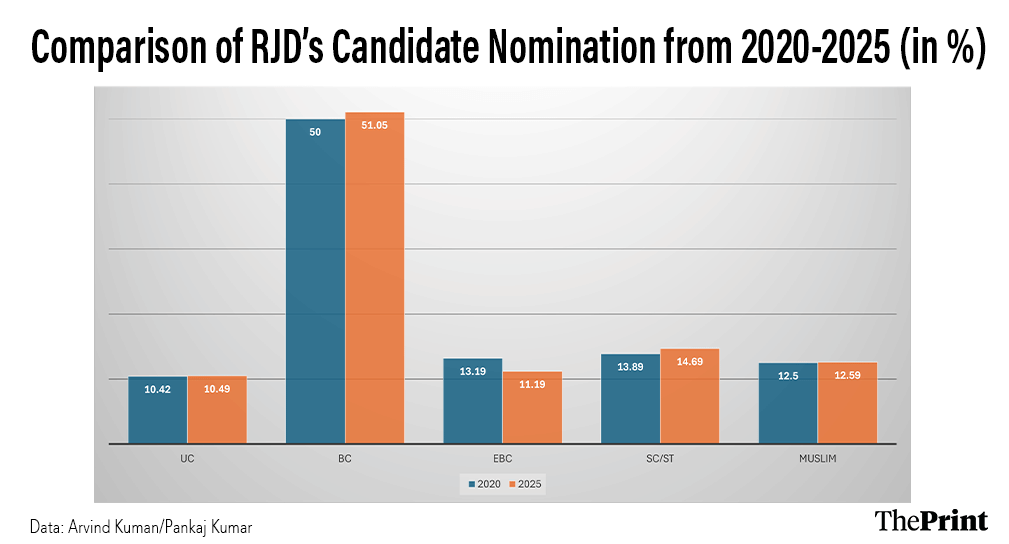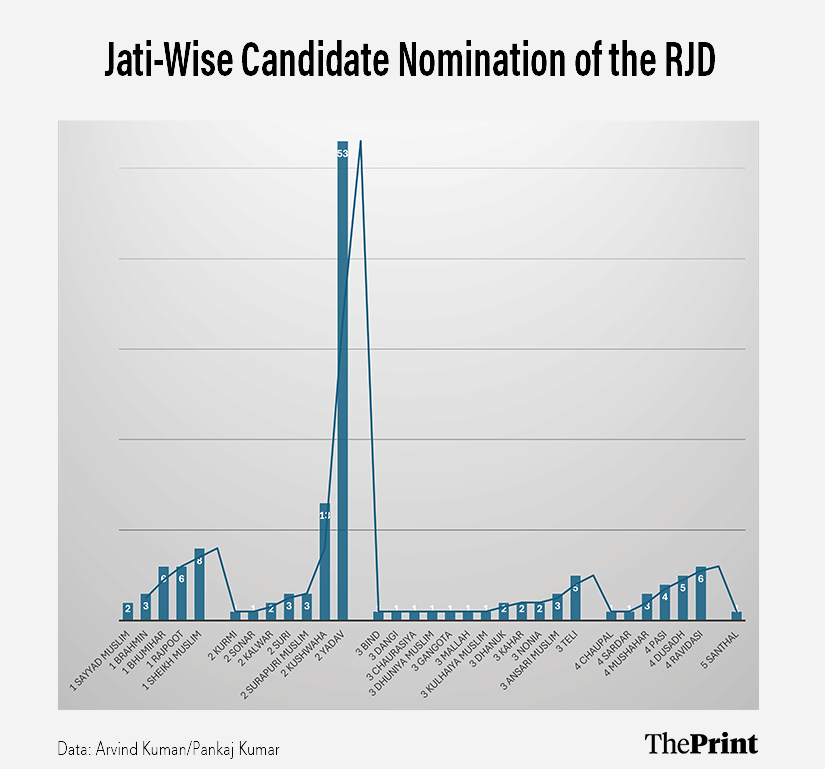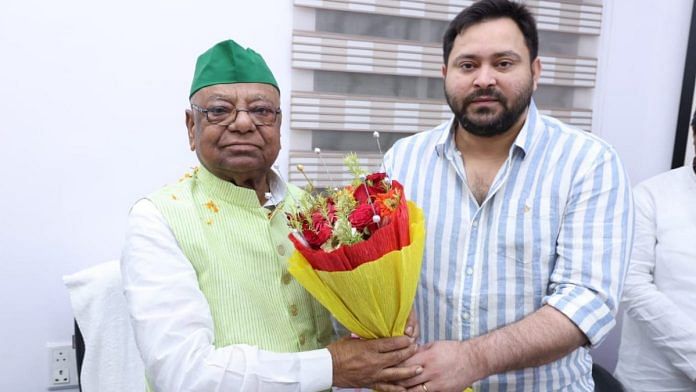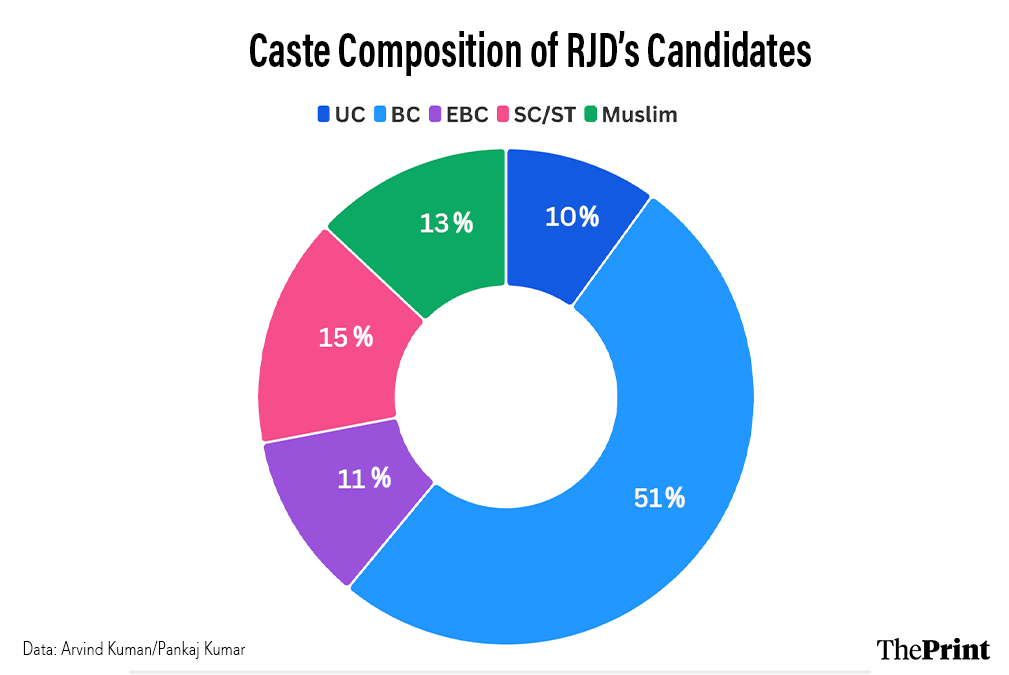Caste has become a key factor in Bihar’s ongoing electoral mobilisation. The current discussions, therefore, focus on the caste composition of candidates. In our previous two articles, we analysed the candidate caste breakdown of the National Democratic Alliance’s two principal constituents — Janata Dal United (JDU) and Bharatiya Janata Party (BJP). The NDA’s two other constituents, Lok Janshakti Party and Rashtriya Lok Morcha, have already publicly announced their candidate caste compositions.
This article analyses the caste backgrounds of candidates fielded by the Rashtriya Janata Dal (RJD). After compiling data through interviews with local leaders and experts across Bihar, we found that half of the RJD’s candidates are from backward castes.
Nominations from Extremely Backward Classes (EBCs) have decreased, while those from backward castes have gone up. It shows that the party’s focus has shifted toward backward castes.
Caste composition of RJD candidates
RJD is the principal constituent of the opposition INDIA bloc in North India. The party leader, Tejashwi Yadav, did pre-electoral roadshows with Congress’ Rahul Gandhi, but both parties could not agree on a seat-sharing formula till the last moment. Therefore, they announced their candidates separately. The RJD has declared candidates for 143 constituencies. In the 2020 Assembly election, the party contested on 144 seats. So, there is not much change in terms of the number of seats.
Figure 1 shows the caste-wise distribution of tickets by the RJD across four social groups—upper castes (15), Backward Classes (73), Extremely Backward Classes (16), Scheduled Castes/Scheduled Tribes (21), and Muslims (18). Here, upper castes, backward castes, and extremely backward castes mean castes that belong to Hinduism. All such castes that profess Islam are clubbed under the Muslim category for analysis. The figure reveals that around half of the RJD’s candidates are from backward castes.
Figure 1
Shift from 2020 polls
Figure 2 provides a comparative analysis of the caste composition of RJD candidates in the 2020 and 2025 Bihar elections. It shows that the party has not made any radical change this time. However, upper caste candidates have slightly increased from 10.42 per cent to just 10.59 per cent, backward caste candidates from 50 per cent to 51.05 per cent, SC/ST candidates from 13.89 per cent to 14.69 per cent, and Muslim candidates from 12.5 per cent to just 12.59 per cent. The candidates from EBCs have declined from 13.13 per cent to 11.19 per cent. This could be because the party saw the lowest strike rate among EBC candidates in the 2020 polls. However, the RJD has tried to woo EBCs by appointing the party’s state president from the community and issuing a separate manifesto for it. But, when it comes to nominating candidates, the party seems to be reluctant.
Figure 2

Also read: TV news isn’t telling which way Bihar Assembly election will go — only who is unhappy
Jati-wise composition of candidates
Figure 3 shows the jati-wise candidate nomination of the RJD. Among all jatis, it has nominated the most number of candidates from the Yadav caste (53), which is its core vote bank, along with Muslims. However, the party has given five tickets fewer to the Yadav community this time, as compared to the previous election, when Yadav candidates were fielded from 58 constituencies.
Among all upper castes, the party has nominated the highest number of candidates from the Sheikh Muslim community (8), followed by Rajput (6), Bhumihar (6), Brahmin (3), and Sayyad Muslim (2). Surprisingly, it has not nominated a single candidate from the Kayasth caste, which is the most educated and economically advanced in the state, according to an analysis based on the Bihar caste survey.
Figure 3

Among all backward castes, irrespective of religion, the RJD has nominated its highest number candidates from Yadavs (53), followed by Kushwaha (13), Surjapuri Muslim (3), Suri (3), Kalwar (2), Sonar (1), and Kurmi (1). Interestingly, the Kushwaha is the only community among the backward castes that is highly nominated by all three major parties — BJP, JDU, and RJD. This is despite the community having a separate party — the Rashtriya Lok Morcha (RLM) led by Upendra Kushwaha.
EBCs are considered a strong support base of Nitish Kumar, and to break it, the RJD has appointed its state president from this community and launched a separate programme. However, when we see the nomination from this caste group, the party has picked the highest number of candidates from Teli (5), followed by Ansari Muslim (3), Nonia (2), Kahar (2), Dhanuk (2), Kulahiya Muslim (1), Mallah (1), Gangota (1), Dhuniya Muslim (1), Chaurasiya (1), Dangi (1), and Bind (1). Here, the strategy of the party seems to be to nominate candidates from more castes.
The RJD has fielded all its SC/ST candidates from reserved constituencies. It has nominated the highest number of candidates from Ravidas (6), followed by Dusadh (5), Pasi (4), Mushahar (3), Sardar (1), and Chaupal (1). Its lone ST candidate is from the Santhal community.
The caste–wise ticket distribution strategy of the RJD shows a lack of radical departure from the previous election. The party has again nominated its highest number of candidates from the Yadav community. The opposition parties might use this factor to promote mobilisation against Yadavs among EBCs. In the last few months, the party has made a few attempts to mobilise EBCs, but it has not resulted in candidate nomination.
Arvind Kumar is a visiting lecturer in politics & international relations at the University of Hertfordshire and an associate fellow at the Institute of Commonwealth Studies, University of London. He tweets @arvind_kumar__Pankaj Kumar is a PhD Scholar at Jamia Millia Islamia. Views are personal.
(Edited by Aamaan Alam Khan)








It’s quite nice work, which just not shows data but also reflects a shift since 2020 in bihar politics . It Shows a comprehensive analysis of representatives of different sections of society and gives an overview how genisis of caste is deeply rooted in society and also used as a tool for popular mobilisation.
Good thing about this article is representation of graphs to track transition if it happened.
Thanks.